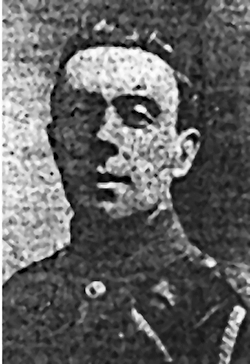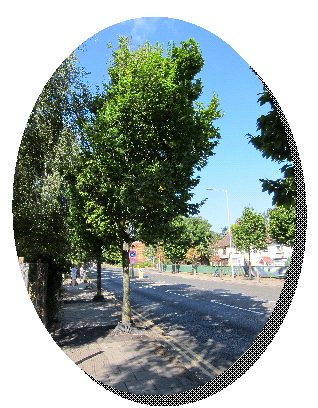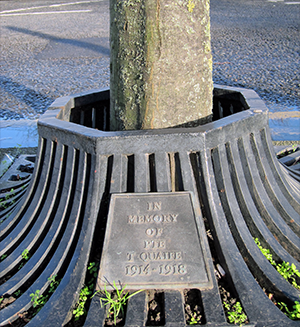First World War Project
Thomas QUAIFE (of Lynsted)
b. 28th June 1891 Private, Service Number T/270324 |

 The youngest of the four children of Thomas, a maltster, and Mary Ann, Thomas was born in Cranbrook on 28 June 1891. Thomas had two older brothers, Ernest Henry and Frank William. Sadly, Ernest died aged 27 in August 1901. He also had an older sister, Ada Elizabeth.
The youngest of the four children of Thomas, a maltster, and Mary Ann, Thomas was born in Cranbrook on 28 June 1891. Thomas had two older brothers, Ernest Henry and Frank William. Sadly, Ernest died aged 27 in August 1901. He also had an older sister, Ada Elizabeth.
Thomas's father died in 1904, after which his mother moved the family to 36 Unity Street, Milton, Sittingbourne. Thomas took up employment as a shop assistant in Boots, and his brother Frank became a postman. His sister had worked as a parlour maid in Notting Hill and in 1914 married Edward C Smith.
Although Thomas appears on the Lynsted War Memorial, his link with Lynsted is unclear. There are no records linking him or any of his siblings with the area. However, some records indicate that he may have been employed by the Cooperative Society in the boot department of its Sittingbourne store in East Street. The Cooperative Society had a large presence in Greenstreet, where he may also have worked.
Thomas enlisted in the Royal East Kent Yeomanry, (The Duke of Connaught's Own) (Mounted Rifles) in Canterbury in 1915, and was posted into the 3/1st Training Unit. It appears that he later transferred into the 1/1st and was posted abroad with the Egyptian Expeditionary Force in April 1916. By then the regiment had been dismounted, due to the lack of horses, and had become an infantry regiment.
He served first in the Suez Canal Zone; in July 1916 the Regiment moved on to Sollum, situated on the western border of Egypt.
It became clear that the Yeomanry regiments were not going to be re-mounted. Men were fiercely proud to serve in a regiment that bore the name of their county of origin and these associations were respected as far as could be. So on 1 February 1917, the 1/1st West Kent Yeomanry, which was stationed in the coastal town of Matruh 125 miles west of Alexandria, amalgamated with 1/1st Royal East Kent Mounted Rifles to become the newly formed 10th (Royal East Kent & West Kent Yeomanry) Battalion, The Buffs (East Kent Regiment). The new Battalion was made up of 46 officers and 875 other ranks. A and B Companies were made up of men from East Kent and C and D Companies of men from West Kent. The 10th Battalion formed part of the 230th Brigade, 74th Division. The new Battalion formed part of Allenby's Force, which was to be successful in the Palestine offensive against the Turkish Army.
Thomas was part of the newly formed "B" Company, 10th (Royal East Kent & West Kent Yeomanry) Battalion, The Buffs (East Kent Regiment), and in early March sailed from Sollum, Egypt, for Alexandria. From there, Thomas's destination was Sidi Bishr, where the new Battalion was to be equipped. Allenby's plan was to advance slowly and steadily up the coast of Palestine, moving troops forward as fast as the railway could be laid to ensure supplies could reach them.
On 11 April 1917, the 10th Buffs arrived at Deir el Belah, where a strong defensive position was being held. On 15 April, they were ordered to provide outpost duty just north of the Wadi (Arabic for a water-course or river bed that is usually dry unless there is rain) Ghuzze. Preparations were being made for the Second Battle of Gaza, which was scheduled for 17/18 April. Fortunately for Thomas, the 74th Division were held in reserve; but following the battle, trench warfare was decided on until reinforcements could arrive. Therefore, on the 23 April, the Buffs occupied a line in the region of Tel el Jemmi, where they dug trenches. It was a task made more difficult, because they worked in the knowledge that the victory they had expected had not been realised.
The following extract from the 'Historical Records of the Buffs' describes the conditions faced by the 10th Battalion:
"The heat was now becoming intense; that scourge of the country, the hot Khaseem wind was blowing, work was hard and, what was worse than anything else, water was scarce. However, after a few days, a move was made to Shellal and Hisea, still in the Wadi, and here water was found and men could indulge in a wash. For a considerable period the digging of trenches was proceeded with, amidst all sorts of trials and troubles: the heat grew fiercer and fiercer as the season advanced; and, with the heat, animal life in the shape of scorpions, lice, flies, mosquitoes and spiders flourished and multiplied exceedingly………….
…………...the next move of the Buffs, which took place on the night of the 27th May, was to the Wadi Levi, which is close to Sheikh Abbas, and from this centre working parties were sent out day and night to improve the front-line trenches or make elaborate redoubts in the second line of defence. During the stay in this Wadi the battalion suffered a good deal of sickness, there being many cases of scarlet fever and diphtheria; also nearly everybody developed boils and blains. It was discovered later that the dug-outs occupied had previously been inhabited by men suffering from the more serious complaints, but the sores were directly attributable to the want of vegetables owing to the difficulties in transport."
The supreme command of the Egyptian Expeditionary Force was handed over to Allenby on 28 June 1917 and, as a result, Thomas's long period of hard digging was to be replaced with intensive training. On 9 July 1917, the Buffs marched to a reserved area, known as Dorset House, where, after a brief rest, they undertook day and night attack, and musketry training. A month later, on the night of 7 August, the Battalion marched to the sand dunes 2 miles south west of Deir el Belah to practise field firing. One month later, on the night of 5 September, the Buffs were again digging trenches near Wadi Ghuzze. Much to the relief of the men, this trench reached down to the sea. Sea bathing made a very pleasant change to their recent situation.
As the hottest of the weather was now behind them, plans were being made and the men knew that they would soon be back in action. Indeed, Allenby had always planned that fighting would have to be postponed until the cooler season.
Again, the following extract from the 'Historical Records of the Buffs' describes some of the logistical problems faced:
"Water was Allenby's trouble. He could not keep the field without it and it affected his whole plan of campaign. No stroke at all could be effected without long and careful preparation for the necessary supply of water, and no preparation, however careful, could make that supply anything but a meagre one. A pipe-line 147 miles long brought up what was actually necessary from the Land of Egypt as far as the Wadi, whence it was camel-borne to the troops.
There was, however, water at Beersheba and the general determined that it would be his. He would make a tremendous demonstration, in which the fleet would cooperate, opposite Gaza and cause the enemy to believe that he was determined to take that place. Then while this great feint held the Turks' attention, he would strike resolutely at Beersheba on his other flank. There were great difficulties in the way. There were no roads, which meant that pack animals must carry all necessary stores, and the country was cut up by Wadis that even to move these camels and mules became a considerable difficulty. The railways were improved: the coastal line was pushed on to Khan Yunos; another was made from Dera Belah to a point on the Wadi Ghuzze, and a new one as far towards Beersheba as was safe. The men were carefully trained to exist on as little water as possible and to march with empty water bottles."
Thomas's Battalion started the march south-eastward on the night of 25 October. Four cloudless nights later, they met with the rest of the division at El Khasif, approximately 6 miles from the Turkish lines. In the moonlight of the night of 30 October, all units moved into their battle positions without a hitch. All was now ready for the commencement of the Battle of Beersheba.
It is probable that Thomas sustained the wounds that were to prove fatal, during this battle - B Company being the first to go over the top. The following is a description of the battle by one who was there:
"We reached our jumping-off point around midnight, and at 4am on 31st the advance began with B and C Companies, the unit on our right being the 25th Royal Welch Fusiliers and on the left the 12th Norfolks. Our objective being Z.6. Z.7 works. This consisted of a line of trenches cut in white limestone rock, cleverly sited on the forward slope of a steep gully. A communication trench ran back into sloping ground in the rear of the wire was about seventy to one hundred yards down the sloping front. The leading waves of B and C Companies came under heavy shrapnel fire almost directly they started and the battalion suffered about 60 casualties, but, by continuing their advance and making use of dead ground, they reached Hill 960, which was about one thousand two hundred yards from their objective. It became necessary to bring in D Company into the line to fill a gap caused by the brigade on the right being drawn away. About 10am the 60th Division, who were on the right of the 74th, took Point 1070, and at 12.30 the final attack on Z.6 works was begun and, after a fierce fight, the position was captured. An intensive bombardment had previously been concentrated on the wire, but it was found to have been very ineffectual. By 1.30 the outpost line had been thrown out east of the captured positions and there the men remained for the night. It had been a very long and trying day's fighting in the hot sun and wearing heavy packs and winter serges, which had been issued two days before the advance."
On the evening of 31 October, news came through that Beersheba had fallen. On that day, 9 men were killed, 6 officers and 98 other ranks wounded, 4 missing, 2 shell-shocked and 2 with injuries sustained on the rough ground. On the 1 November the Battalion was moved back to Wadi Saba.
The availability of water in Beersheba had been exaggerated and it was found inadequate for the size of the force it needed to support.
Thomas died of wounds on 4 November, not on 2 November as recorded on the Lynsted memorial, where he is also recorded in his old Yeomanry Regiment. None of Thomas's service records have survived so it is unclear how much medical attention he received in the four days prior to his death.
| East Kent Gazette of 24th November 1917 |
SITTINGBOURNE CO-OPERATIVE EMPLOYEE DIES IS PALESTINE Official news has been received of the death in Palestine, from wounds received in action on November 4th, of Private Thomas Quaife, aged 27, of the East Kent Mounted Rifles, attached to the Buffs. Thomas Quaife, who was single, was a native of Cranbrook. But for many years he was employed in the boot department of the Sittingbourne Co-operative Society's Stores, East Street. He joined the East Kent Yeomanry in 1915, and at the time he died he had for 18 months served in the Egyptian Expeditionary Force, in which he had been attached to one of the battalions of the Buffs. Thomas Quaife was in action in Beersheba on October 31st, and presumably he received his fatal wounds in the attack on Gaza. The young man was much liked by his fellow employees, and he is one more of the young fellows in the service of the Sittingbourne Co-operative Society who have nobly laid down their lives for King and Country. The deceased was the brother of Private Frank William Quaife (a member of the Sittingbourne Postal Staff), who is now serving in a Labour Company of the Essex Regiment, and is billeted at 13 Hackney Road, Maidstone. |
Thomas is buried in Kantara War Memorial Cemetery in Egypt in grave number E.41. Kantara was a major base and hospital centre, and the cemetery was established in February 1916 for burials of those who died in various hospitals. Post Armistice, the cemetery was extended to enable bodies to be exhumed from cemeteries and battlefields around Rumani, Qatia, El Arish and Rafa, and reburied. It is likely that Thomas's was one of the graves that was exhumed and reburied.
Thomas was posthumously awarded the British War and the Victory medals. [See Appendix 1]
In March 1918, Thomas's brother, Frank, received his owed pay of £6 9s 7d (£6.48p). In December 1919 he also received his War Gratuity of £11 10s (£11.50p). [See Appendix 2] Taken together these amount to roughly £980 in today's money.
Remembrance Avenue, Sittingbourne
 In 1921, money was raised for trees to be planted in what is now known as the Avenue of Remembrance in Sittingbourne. Each tree was dedicated to one of the fallen from Sittingbourne, including Thomas.
In 1921, money was raised for trees to be planted in what is now known as the Avenue of Remembrance in Sittingbourne. Each tree was dedicated to one of the fallen from Sittingbourne, including Thomas.
Sadly, the original trees were removed when the surrounding area was regenerated. In 1996 Swale Borough Council, J Sainsbury PLC and Save our Living Memorial, with cooperation of the Royal British Legion Ex-Servicemen Association, planted new trees. Thomas's tree sits close to the junction of the Avenue of Remembrance and Bell Road.


 World War 1 Pages
World War 1 Pages